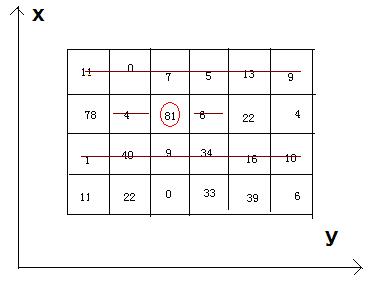描述
Bean-eating is an interesting game, everyone owns an M*N matrix, which is filled with different qualities beans. Meantime, there is only one bean in any 1*1 grid. Now you want to eat the beans and collect the qualities, but everyone must obey by the following rules: if you eat the bean at the coordinate(x, y), you can’t eat the beans anyway at the coordinates listed (if exiting): (x, y-1), (x, y+1), and the both rows whose abscissas are x-1 and x+1.

Now, how much qualities can you eat and then get ?
- 输入
-
There are a few cases. In each case, there are two integer M (row number) and N (column number). The next M lines each contain N integers, representing the qualities of the beans. We can make sure that the quality of bean isn't beyond 1000, and 1<=M,N<=500.
- 输出
-
For each case, you just output the MAX qualities you can eat and then get.
- 样例输入
-
4 6 11 0 7 5 13 9 78 4 81 6 22 4 1 40 9 34 16 10 11 22 0 33 39 6
- 样例输出
-
242思路:
考虑对于某行某列元素,row[i][j]表示加上位置为i,j的土豆的质量的i行j列最大的和
列的最大值:row[i][j]=max(row[i][j-2]+row[i][j-3])+val
看图说话:

假设红色的格子为i行j列,那么它的前面有两种选择方案:
1、选择蓝色格子
2、选择黄色格子
那么该行最大的和是什么呢?
由于n列、n-1列具有状态无关性(n-1列的状态影响不了n列的状态),很显然等于max(row[i][n],row[i][n-1])
同理对于dp[i] (i行的最大值)
dp[i]=max(dp[i-2],dp[i-3])+max_row[i]
看图说话:

max土豆质量=max(dp[m],dp[m-1])
为了方便计算,我的代码把n,m扩大了2
AC代码:
1 #include <iostream> 2 #include <cstdio> 3 #include <cstring> 4 using namespace std; 5 #define N 506 6 int n,m; 7 int col[N][N]; 8 int dp[N]; 9 int main() 10 { 11 while(scanf("%d%d",&n,&m)==2){ 12 memset(col,0,sizeof(col)); 13 memset(dp,0,sizeof(dp)); 14 for(int i=3;i<n+3;i++){ 15 for(int j=3;j<m+3;j++){ 16 int x; 17 scanf("%d",&x); 18 col[i][j] = max(col[i][j-2],col[i][j-3])+x; 19 } 20 } 21 for(int i=3;i<n+3;i++){ 22 dp[i]=max(dp[i-2],dp[i-3])+max(col[i][m+1],col[i][m+2]); 23 } 24 printf("%d ",max(dp[n+1],dp[n+2])); 25 } 26 return 0; 27 }